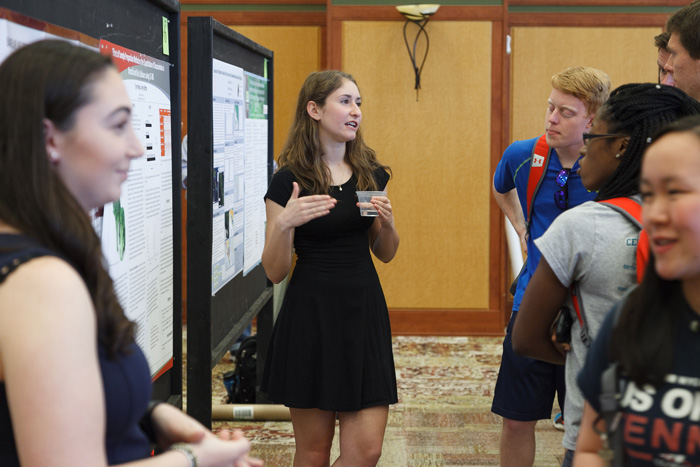Research Revealed

Photo by Carl Socolow '77.
Student researchers present work at the 32nd Annual Science Student Research Symposium
by Katya Hrichak '17
Student researchers filled the HUB Social Hall with posters and enthusiastic presentations April 12 during the 32nd Annual Science Student Research Symposium. The 55 projects represented a variety of disciplines, including biochemistry & molecular biology, biology, chemistry, earth sciences, environmental studies & environmental science, mathematics, computer science, neuroscience, physics & astronomy and psychology.
During the past 31 symposiums, faculty members determined which projects received recognition. This year, the professors allowed students to judge in order to increase interactions among them. From this year’s 55 projects, four projects were recognized: first place was awarded to “Voluntary Exercise Slows Extinction of Conditioned Hyperactivity in Mice” by Abigail Stasior ’17, Brooke Bender, ’17, Jonathan Legregin ’17 and Justina Warnick ’20; second place to “Effects of Ocean Acidification and Salinity Stress on Development and Behavior in Larvae of a Marine Gastropod” by Rulaiha Taylor ’18, Alissa Resnikoff ’18 and Megan Sansevere ’18; and third place to “The Mystery Behind the Increasing Brightness of GM Ori” and “A Sudden Change in Amplitude of V723 Cas,” both by Jacob Grant ’17.
One of the many students presenting was Surya Brown-Moffit ’17, whose research was titled, “Kinematics of Feeding Behavior in the American Toad: Terrestrial Versus Elevated Prey.” Through her research, she aimed to characterize the differences between the two types of prey and assess the American toad’s vertical limits. Having collected the toads she studied from the College Farm, she hopes her research on their feeding habits will be immediately beneficial: “The Dickinson College Farm is currently attempting to naturally use the American toad as a biological control organism in hopes they will eat pest insects, reducing the need for pesticides,” she says.
Presenting research in this setting, Assistant Professor of Earth Sciences Alyson Thibodeau says, is “a great opportunity for students of different departments to come together to learn about each other’s research and to practice communicating science to one another.” James Midkiff ’17 agrees, having discussed his research, “Heuristic Approaches to Nonlinear 0-1 Knapsack Problems,” during the symposium. “I have gained much experience explaining [my] research to others from various academic fields,” he says. “I’m hoping I can take what I learned from the symposium and successfully apply it toward my upcoming honors defense as well as my future career.”
Although her post-graduation plans do not focus on zooplankton, as did her research project “Long-Term Trends of Climate-Induced Changes in the Zooplankton of West Greenland Lakes,” Helen Schlimm ’17 looks forward to putting similar interests to work. “I am planning to work in an environmental organization focused on environmental management and remediation of the Chesapeake Bay. ... I want to combine these interests [in freshwater resources and climate change] in a position where I can also work with communities and implement on-the-ground conservation projects,” she says. “I am looking forward to where life takes me!”
Learn more
Published April 18, 2017